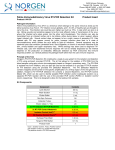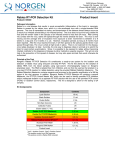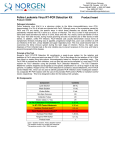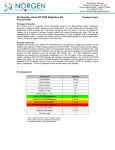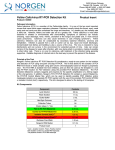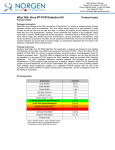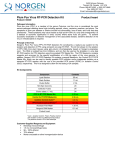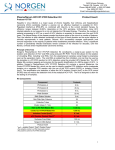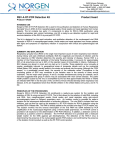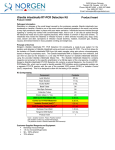Download Feline Infectious Peritonitis Virus RT-PCR Detection Kit
Transcript
3430 Schmon Parkway Thorold, ON, Canada L2V 4Y6 Phone: 866-667-4362 • (905) 227-8848 Fax: (905) 227-1061 Email: [email protected] Feline Infectious Peritonitis Virus RT-PCR Detection Kit Product Insert Product # 44400 Pathogen Information Feline infectious peritonitis (FIP) is a viral disease of cats caused by the Feline Infectious Peritonitis Virus (FIPV), which is a strain of feline coronavirus. Most strains of feline coronavirus are avirulent, which means that they do not cause disease, and are referred to as feline enteric coronavirus. Cats infected with a feline coronavirus generally do not show any symptoms during the initial viral infection. Feline coronaviruses can be found in large quantities in the saliva and feces of cats during the acute infection and to a lesser extent in recovered or carrier cats, so it can be transmitted through cat-to-cat contact and exposure to feces. In a small percent of infected cats (5 to 10 percent), the infection progresses into clinical FIP either by a mutation of the virus or by an aberration of the immune response. The virus is then referred to as feline infectious peritonitis virus (FIPV), and typically higher concentrations of the virus can then be detected in blood samples. Cats that have been initially exposed to the feline coronavirus usually show no obvious symptoms. Once symptoms develop, often there is increasing severity over the course of several weeks, ending in death. Any cat that is a carrier of any coronavirus is at risk of developing FIP. Cats with weakened immune systems, kittens, cats already infected with feline leukemia virus and geriatric cats are especially at risk. There is no known cure or effective treatment for FIP at this time. Principle of the Test Norgen’s FIPV RT- PCR Detection Kit constituents a ready-to-use system for the isolation and detection of FIPV using end-point one step RT-PCR. The kit first allows for the isolation of FIPV RNA from the blood samples using spin-column chromatography based on Norgen’s proprietary resin. The FIPV RNA is isolated free from inhibitors, and can then be used as the template in a one step RT-PCR reaction for FIPV detection using the provided FIPV Master Mix. The FIPV Mastermix contains reagents and enzymes for the specific amplification of a 304 bp region of the viral genome. In addition, Norgen’s FIPV RT-PCR Detection Kit contains a second Mastermix, the RT-PCR Control Master Mix, which can be used to identify possible PCR inhibition and/or inadequate isolation via a separate RTPCR reaction with the use of the provided PCR control (PCRC) or Isolation Control (IsoC), respectively. This kit is designed to allow for the testing of 24 samples. Kit Components: Component Contents Lysis Solution 30 mL Wash Solution 11 mL Elution Buffer 2 mL Mini Spin Columns 24 Collection Tubes 24 Elution tubes (1.7 mL) 24 FIPV 2x RT-PCR Master Mix 0.35 mL Control 2x RT-PCR Mastermix 0.35 mL a Isolation Control (IsoC)* 0.3 mL b FIPV Positive Control (PosC)* 0.1 mL Nuclease Free-Water 1.25 mL Norgen’s DNA Marker 0.1 mL Product Insert 1 * IsoC = Isolation Control ; PosC= Positive Control a b The isolation control is a cloned PCR product. The positive control is a partial FIPV RNA transcript Customer-Supplied Reagents and Equipment • Benchtop microcentrifuge • 95-100% ethanol • Thermocycler and or Real-Time PCR System • Micropipettes with an accuracy range between 1-10 µL, 10-100 µL and 100-1000 µL • Laminar flow hood for extractions • Vortex • Sterile, nuclease-free aerosol-barrier micropipettor tips • Microcentrifuge tube rack • Disposable latex gloves • β-mercaptoethanol Storage Conditions and Product Stability • The Positive Control (FIPV PosC, red cap) and Isolation Control (IsoC, orange cap) should be stored at -70°C. If needed, make aliquots of the controls according to the volume used in the protocol (10 µL of FIPV PosC or 20 µL of IsoC) prior to freezing. • The FIPV 2X Detection RT-PCR Mastermix and the Control 2X RT-PCR Mastermix should be stored at -20°C upon receipt (-70°C for long-term). Make appropriate aliquots and store at -20°C if needed. • All other kit components may be stored at room temperature • The FIPV 2X Detection RT-PCR Mastermix and the Control 2X RT-PCR Mastermix, Positive Control and Isolation Control should not undergo repeated freeze-thaw (a maximum freeze-thaw of three times). • For RT-PCR: • Allow reagents to thaw at room temperature prior to use • When thawed, mix the components and centrifuge briefly • Work quickly on ice • After addition of RT-PCR Mastermix use within one hour Quality Control In accordance with Norgen’s ISO 9001 and ISO 13485-certified Quality Management System, each lot of Norgen’s FIPV RT-PCR Detection Kit, including the FIPV 2x Detection RT-PCR Mastermix, Control 2X RT-PCR Mastermix, Isolation Control and FIPV Positive Control are tested against predetermined specifications to ensure consistent product quality. Product Use Limitations Norgen’s FIPV RT-PCR Detection Kit is designed for research purposes only. Product Warranty and Satisfaction Guarantee NORGEN BIOTEK CORPORATION guarantees the performance of all products in the manner described in our product manual. The customer must determine the suitability of the product for its particular use. Disclaimers The Lysis Solution contains guanidinium salts, and should be handled with care. Guanidinium salts form highly reactive compounds when combined with bleach, thus care must be taken to properly dispose of any of these solutions Blood of all human and animal subjects is considered potentially infectious. All necessary precautions recommended by the appropriate authorities in the country of use should be taken when working with whole blood. Safety Information Ensure that a suitable lab coat, disposable gloves and protective goggles are worn when working with chemicals. For more information, please consult the appropriate Material Safety Data Sheets (MSDSs). These are available as convenient PDF files online at www.norgenbiotek.com. CAUTION: DO NOT add bleach or acidic solutions directly to the sample-preparation waste. General Precautions • Follow universal precautions. All specimens should be considered as potentially infectious and handled accordingly. • Wear personal protective equipment, including gloves and lab coats when handling kit reagents. Wash hands thoroughly when finished performing the test. • Dispose of unused kit reagents and specimens according to local, provincial or federal regulations. • Workflow in the laboratory should proceed in a uni-directional manner, beginning in the preamplification area(s) (i.e. specimen collection and RNA extraction) and moving to the amplification / detection area(s) (RT-PCR and gel electrophoresis). • Do not use supplies and equipment across the dedicated areas of specimen extraction and sample preparation. No cross-movement should be allowed between the different areas. • Personal protective equipment, such as laboratory coats and disposable gloves, should be area specific. • Only use the protocol provided in this insert. Alterations to the protocol and deviations from the times and temperatures specified may lead to erroneous results. Working with RNA RNases are very stable and robust enzymes that degrade RNA. Autoclaving solutions and glassware is not always sufficient to actively remove these enzymes. The first step when preparing to work with RNA is to create an RNase-free environment. The following precautions are recommended as your best defense against these enzymes. • • • • • • The RNA area should be located away from microbiological work stations. Clean, disposable gloves should be worn at all times when handling reagents, samples, pipettes, disposable tubes, etc. It is recommended that gloves are changed frequently to avoid contamination. There should be designated solutions, tips, tubes, lab coats, pipettes, etc. for RNA only. All RNA solutions should be prepared using at least 0.05% DEPC-treated autoclaved water or molecular biology grade nuclease-free water. Clean all surfaces with commercially available RNase decontamination solutions. When working with purified RNA samples, ensure that they remain on ice during downstream applications. Protocol A. FIPV Total RNA Isolation Important Notes Prior to Beginning Protocol: • Blood of all human and animal subjects is considered potentially infectious. All necessary precautions recommended by the appropriate authorities in the country of use should be taken when working with whole blood. • All centrifugation steps are carried out in a benchtop microcentrifuge at 14,000 x g (~ 14,000 RPM) except where noted. All centrifugation steps are performed at room temperature. • A variable speed microcentrifuge should be used for maximum kit performance. If a variable speed centrifuge is not available a fixed speed centrifuge can be used, however reduced yields may be observed. • Ensure that all solutions are at room temperature prior to use. • • • • • • • Prepare a working concentration of the Wash Solution by adding 25 mL of 95 - 100 % ethanol (provided by the user) to the supplied bottle containing the concentrated Wash Solution. This will give a final volume of 36 mL. The label on the bottle has a box that may be checked to indicate that the ethanol has been added. It is recommended that no more than 100 µL of blood be used in order to prevent clogging of the column. We recommend the use of this kit to isolate RNA from non-coagulating fresh blood using EDTA as the anti-coagulant. It is important to work quickly during this procedure. Isolation Control (IsoC) A FIPV Isolation Control (IsoC) is supplied. This allows the user to control the RNA isolation procedure. For this assay, add the Isolation Control (IsoC) to the lysate during the isolation procedure The Isolation Control (IsoC) must not be added to the sample material directly. Do not freeze and thaw the Isolation Control (IsoC) more than 2 times. The Isolation Control (IsoC) must be kept on ice at all times during the isolation procedure. The RT-PCR components of the FIPV RT-PCR Detection Kit should remain at -20oC until RNA is extracted and ready for RT-PCR amplification. It is important to work quickly during this procedure. A. LYSATE PREPARATION 1. Cell Lysate Preparation from Blood a. Transfer up to 100 µL of non-coagulating blood to an RNase-free microcentrifuge tube (not provided). b. Add 350 µL of Lysis Solution to the blood. Lyse cells by vortexing for 15 seconds. Ensure that mixture becomes transparent before proceeding to the next step. c. Add 200 µL of 95 – 100% ethanol (provided by the user) to the lysate. Mix by vortexing for 10 seconds. Proceed to Step 2. B. SPECIMEN RNA PURIFICATION Following the lysate preparation, viral RNA can be extracted from the specimens using the supplied buffers and solutions according to the following protocol: 1. 2. 3. Add 20 µL of Isolation Control (IsoC) to the lysate mixture. Assemble a column with one of the provided collection tubes. Apply the lysate with ethanol (up to 650 µL) to the column and centrifuge for 1 minute at 14,000 rpm. Note: Ensure the entire lysate volume has passed through into the collection tube by inspecting the column. If the entire lysate volume has not passed through, spin for an additional minute. 4. 5. 6. Discard the flowthrough and reassemble the spin column with its collection tube. Depending on lysate volume, repeat steps B2 and B3. Apply 400 µL of Wash Solution and centrifuge for one minute at 14,000 rpm. Note: Ensure the entire wash solution has passed through into the collection tube by inspecting the column. If the entire wash volume has not passed through, spin for an additional minute. 7. 8. Discard the flowthrough and reassemble the spin column with its collection tube. Repeat steps B5 and B6 two more times (for a total of 3 washes). 9. 10. 11. 12. 13. Spin the column for 2 minutes to thoroughly dry the resin at 14,000 rpm. Discard the collection tube. Place the column into a new 1.7 mL Elution tube. Add 50 µL of Elution Solution to the column. Centrifuge for 2 minutes at 2,000 rpm followed by a 2 minute spin at 14,000 rpm. Note the volume eluted from the column. If the entire 50 µL has not been eluted, spin the column for an additional minute at 14,000 rpm. The purified RNA sample could be used immediately for RT-PCR as described below. It is recommended that samples be placed at -70°C for long term storage. B. FIPV RT-PCR Assay Preparation Notes: • Before use, suitable amounts of all RT-PCR components should be completely thawed at room temperature, vortexed and centrifuged briefly. • The amount of FIPV 2X Detection RT-PCR Mastermix and Control 2X RT-PCR Mastermix provided is enough for up to 32 RT-PCR reactions (24 sample RT-PCR, 4 positive control RT-PCR and 4 no template control RT-PCR) each. • For each sample, one RT-PCR reaction using the FIPV 2X Detection RT-PCR Mastermix and one RT-PCR reaction using Control 2X RT-PCR Mastermix should be set up in order to have a proper interpretation of the results. • For every RT-PCR run, one reaction containing FIPV Positive Control (FIPV PosC) and one reaction as no template control must be included for proper interpretation of results. • The recommended minimum number of RNA samples tested per RT-PCR run is 6. • Using a lower volume from the sample than recommended may affect the sensitivity of FIP Limit of Detection. 1. Prepare the RT-PCR reaction for sample detection (Set #1, using FIPV 2X Detection RT-PCR Mastermix) and the RT-PCR reaction for control detection (Set #2, using Control 2X RT-PCR Mastermix) as shown in Table 1 below. The recommended amount of sample RNA to be used is 2.5 µL. However, a volume between 1 and 5 µL of sample RNA may be used as template. Ensure that one FIPV detection reaction and one control reaction is prepared for each RNA sample. Adjust the final volume of the RT-PCR reaction to 20 µL using the Nuclease-Free Water provided. Table 1. RT-PCR Assay Preparation RT-PCR Components Volume Per RT-PCR Reaction FIPV 2X Detection RT-PCR Master Mix Or Control 2X RT-PCR Master Mix 10 µL Sample RNA 2.5 µL Nuclease-Free Water 7.5 µL Total Volume 20 µL 2. For each RT-PCR set, prepare one positive control RT-PCR as shown in Table 2 below: Table 2. RT-PCR Positive Control Preparation RT-PCR Components Volume Per RT- PCR Reaction FIPV 2X Detection RT-PCR Master Mix Or Control 2X RT-PCR Master Mix 10 µL FIPV Positive Control (PosC) 10 µL Total Volume 20 µL 3. For every RT- PCR set, prepare one no template control RT-PCR as shown in Table 3 below: Table 3. RT-PCR Negative Control Preparation RT-PCR Components Volume Per RT-PCR Reaction FIPV 2X Detection RT- PCR Master Mix Or Control 2X RT-PCR Master Mix 10 µL Nuclease-Free Water 10 µL Total Volume 20 µL Therefore, at a minimum, each PCR run will contain 6 separate RT-PCR reactions. C. One Step RT- PCR Assay Programming 1. Program the thermocylcer according to the program shown in Table 4 below. 2. Run one step RT-PCR. Table 4. FIPV Assay Program One Step RT-PCR Cycle Step Temperature Duration Cycle 1 Step 1 50oC 30 min Cycle 2 Step 1 Step 1 Cycle 3 (35x) o 3 min o 15 sec o 95 C 94 C Step 2 58 C 15 sec Step 3 72oC 30 sec o Cycle 4 Step 1 72 C 5 min Cycle 5 Step 1 4o C ∞ D. FIPV One Step RT- PCR Assay Results Interpretation 1. For the analysis of the RT-PCR data, the entire 15-20 µL RT-PCR Reaction should be loaded on a 1X TAE 1.7% Agarose RNA gel along with 10 µL of Norgen’s RNA Marker (provided). Prepare enough agarose gel for running one set of RT-PCR of FIPV detection and one set of RT-PCR for controls detection. 2. The RT-PCR products should be resolved on the 1X TAE 1.5% Agarose gel at 150V for 30 minutes (Gel running time will be vary depending on an electrophoresis apparatus). 3. Sample results are provided below: M 1 2 3 4 5 6 7 8 NTC M FIPV (304 bp) Figure 1: A representative 1X TAE 1.5% agarose gel showing the amplification of FIPV at different concentrations (FIPV Target). The size of the FIPV target amplicon corresponds to 304 bp as represented by the provided DNA Marker (M). NTC = Negative Control. M 1 2 3 4 5 6 NTC Isolation Control PCR Control Figure 2: A representative 1X TAE 1.7% agarose gel showing the amplification of Isolation Control and PCR Control under different conditions using the Control 2X RT-PCR Mastermix. The size of the Isolation Control amplicon and PCR Control amplicon correspond to 499 bp and 150 bp, respectively, as represented by the provided DNA Marker (M). Lanes 1 to 5 showed detection of both Isolation Control and PCR Control, suggesting that the RNA isolation as well as the RT-PCR reaction was successful. Lane 6 showed only the detection of PCR Control suggesting that while the RT-PCR was successful, the isolation failed to recover even the spiked-in Isolation control. NTC = Negative Control. Table 5. Interpretation of One Step RT-PCR Assay Results Input Type Target reaction Control Reaction Interpretation FIPV Target Band (304 bp) IsoC Band (499 bp) PCRC Band (150 bp) X X X Valid X Valid X X Positive X X Negative X Re-test Positive Control Negative Control Sample X Sample Sample Sample Re-test Sample X Sample X Sample X Negative X X Positive Positive Sample X Re-test or results obtained that are not covered in Table 5 above, please refer to the Troubleshooting Section. E. FIPV RT-PCR Assay Specificity • The specificity of Norgen’s FIPV RT-PCR Detection Kit is first and foremost ensured by the selection of the FIPV specific primers, as well as the selection of stringent reaction conditions. No cross reactivity was found against other Feline viruses such as Feline calici virus, Feline Leukemia Virus and Feline Immunodeficiency Virus. F. Linear Range • • • • The linear range of Norgen’s FIPV RT-PCR Detection Kit was determined by analysing a dilution series of a FIP quantification standards ranging from 100 ag to 1 pg. Each dilution has been tested in replicates (n = 4) using Norgen’s FIPV RT-PCR Detection Kit on a 1X TAE 1.7% agarose gel. The linear range of Norgen’s FIPV RT-PCR Detection Kit has been determined to cover concentrations from 100 ag to 1 ng Under the conditions of the Norgen’s FIVP RNA Isolation procedure, Norgen’s FIPV RT-PCR Detection Kit covers a linear range from 100 copies to 1 x 106 copies. Frequently Asked Questions 1. How many samples should be included per RT-PCR run? • Norgen’s FIPV RT-PCR Detection Kit is designed to test 24 samples. For every 6 samples, a nontemplate control (Nuclease Free Water) and a Positive Control must be included. It is preferable to pool and test 6 samples at a time. If not, the provided Positive Control is enough to run 3 samples at a time. 2. How can I interpret my results if neither the PCR control nor the Isolation Control (IsoC) amplifies? • If neither the PCR control nor the Isolation Control (IsoC) amplifies, the sample must be re-tested. If the positive control showed amplification, then the problem occurred during the isolation, where as if the Positive control did not amplify, therefore the problem has occurred during the setup of the PCR assay reaction. 3. How should it be interpreted if only the PCR control showed amplification but neither the FIPV target nor the Isolation control amplified for a sample? • This indicates a poor isolation. The isolation procedure must be repeated. 4. How should it be interpreted if only the Isolation Control (IsoC) was amplified in a sample? • The sample tested can be considered as FIPV negative. 5. How should it be interpreted if the PCR control and the FIPV target showed amplification in a sample? • The sample tested can be considered positive. It could happen when too much template was added to the reaction. 6. How should it be interpreted if only the FIPV target and the PCR control were amplified in a sample? • The sample tested can be considered as FIPV positive. 7. How should it be interpreted if only the FIPV target was amplified in a sample? • It is recommended that the isolation is repeated. 8. How should it be interpreted if only the PCR control and the Isolation control showed amplification in a sample? • The sample tested can be considered negative 9. What if I forgot to do a dry spin after my third wash? • Your first RNA elution will be contaminated with the Wash Solution. This may dilute the RNA yield in your first elution and it may interfere with the PCR detection, as ethanol is known to be a PCR inhibitor. 10. What if I forgot to add the Isolation Control (IsoC) during the isolation? • It is recommended that the isolation is repeated. 11. What if I forgot to run the Control RT-PCR for the sample and I only ran the Detection RTPCR and I obtained a positive result? • The result can be considered positive. However, any negative result must be verified by running the associated control RT-PCR to ensure that it is a true negative and not a false negative due to problems with the RNA isolation or the RT-PCR reactions. Related Products Product # Total RNA Purification Kit 17200 44100 43900 44300 44000 Feline Immunodeficiency Virus RT-PCR Detection Kit Feline Calicivirus RT-PCR Detection Kit Feline Herpes Virus PCR Detection Kit Feline Leukemia Virus RT-PCR Detection Kit Technical Assistance NORGEN’s Technical Service Department is staffed by experienced scientists with extensive practical and theoretical expertise in sample and assay technologies and the use of NORGEN products. If you have any questions or experience any difficulties regarding Norgen’s FIPV RT-PCR Detection Kit or NORGEN products in general, please do not hesitate to contact us. NORGEN customers are a valuable source of information regarding advanced or specialized uses of our products. This information is helpful to other scientists as well as to the researchers at NORGEN. We therefore encourage you to contact us if you have any suggestions about product performance or new applications and techniques. For technical assistance and more information, please contact our Technical Support Team between the hours of 8:30 and 5:30 (Eastern Standard Time) at (905) 227-8848 or Toll Free at 1-866-667-4362 or call one of the NORGEN local distributors (www.norgenbiotek.com) or through email at [email protected]. 3430 Schmon Parkway, Thorold, ON Canada L2V 4Y6 Phone: (905) 227-8848 Fax: (905) 227-1061 Toll Free in North America: 1-866-667-4362 ©2011 Norgen Biotek Corp. PI44400-4










